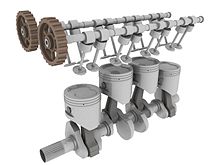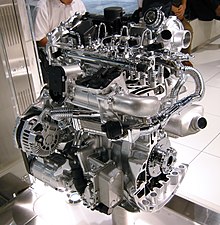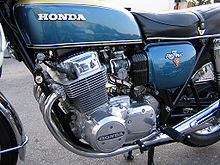Straight-four engine



Astraight-four engine(also referred to as aninline-four engine) is a four-cylinderpiston enginewhere cylinders are arranged in a line along a common crankshaft.
The majority of automotive four-cylinder engines use a straight-four layout[1]: pp. 13–16 (with the exceptions of theflat-four enginesproduced by Subaru and Porsche)[2]and the layout is also very common in motorcycles and other machinery. Therefore the term "four-cylinder engine" is usually synonymous with straight-four engines. When a straight-four engine is installed at an inclined angle (instead of with the cylinders oriented vertically), it is sometimes called aslant-four.
Between 2005 and 2008, the proportion of new vehicles sold in the United States with four-cylinder engines rose from 30% to 47%.[3][4]By the 2020 model year, the share for light-duty vehicles had risen to 59%.[5]
Design
[edit]A four-stroke straight-four engine always has a cylinder on its power stroke, unlike engines with fewer cylinders where there is no power stroke occurring at certain times. Compared with aV4 engineor aflat-four engine,a straight-four engine only has onecylinder head,which reduces complexity and production cost.
Displacement
[edit]Petrol straight-four engines used in modern production cars typically have a displacement of 1.3–2.5 L (79–153 cu in), but larger engines have been used in the past, for example the 1927–1931Bentley 4½ Litre.
Diesel engines have been produced in larger displacements, such as a 3.2 L turbocharged Mitsubishi engine (used the Pajero/Shogun/Montero SUV) and a 3.0 L Toyota engine. European and Asian trucks with agross vehicle weight ratingbetween 7.5 and 18 tonnes typically use inline four-cylinder diesel engines with displacements around 5 litres.[6][7][8][9][10][11][12]Larger displacements are found in locomotive, marine and stationary engines.
Displacement can also be very small, as found inkei carssold in Japan. Several of these engines had four cylinders at a time when regulations dictated a maximum displacement of 550 cc; the maximum size is currently at 660 cc.
Primary and secondary balance
[edit]Straight-four engines with the preferred crankshaft configuration have perfectprimary balance.[1]: p. 12 This is because the pistons are moving in pairs, and one pair of pistons is always moving up at the same time as the other pair is moving down.
However, straight-four engines have asecondary imbalance.This is caused by the acceleration/deceleration of the pistons during the top half of the crankshaft rotation being greater than that of the pistons in the bottom half of the crankshaft rotation (because the connecting rods are not infinitely long). As a result, two pistons are always accelerating faster in one direction, while the other two are accelerating more slowly in the other direction, which leads to a secondary dynamic imbalance that causes an up-and-down vibration at twice crankshaft speed. This imbalance is common among all piston engines, but the effect is particularly strong on four-stroke inline-four because of the two pistons always moving together.
The strength of this imbalance is determined by the reciprocating mass, the ratio of connecting rod length to stroke, and the peak piston velocity. Therefore, small displacement engines with light pistons show little effect, and racing engines use long connecting rods. However, the effectgrows quadraticallywith engine speed (rpm).
Pulsations in power delivery
[edit]
Four-stroke engineswith five or more cylinders are able to have at least one cylinder performing its power stroke at any given point in time. However, four-cylinder engines have gaps in the power delivery, since each cylinder completes its power stroke before the next piston starts a new power stroke. This pulsating delivery of power results in more vibrations than engines with more than four cylinders.
Usage of balance shafts
[edit]Abalance shaftsystem is sometimes used to reduce the vibrations created by a straight-four engine, most often in engines with larger displacements. The balance shaft system was invented in 1911 and consists of two shafts carrying identicaleccentricweights that rotate in opposite directions at twice the crankshaft's speed.[1]: pp. 42–44 This system was patented by Mitsubishi Motors in the 1970s and has since been used under licence by several other companies.[13][14]
Not all large displacement straight-four engines have used balance shafts, however. Examples of relatively large engines without balance shafts include the 2.4 litreCitroën DSengine, the 2.6 litreAustin-Healey 100engine, the 3.3 LFord Model A (1927)engine and the 2.5 LGM Iron Duke engine.Soviet/RussianGAZ VolgaandUAZengines with displacements of up to 2.9 litres were produced without balance shafts from the 1950s to the 1990s, however these were relatively low-revving engines which reduces the need for a balance shaft system.[1]: pp. 40–44
Usage in production cars
[edit]

Most modern straight-four engines used in cars have a displacement of 1.5–2.5 L (92–153 cu in). The smallest automotive straight-four engine was used in the 1963–1967Honda T360kei truck and has a displacement of 356 cc (21.7 cu in), while the largest mass-produced straight-four car engine is the 1999–2019Mitsubishi 4M41diesel engine which was used in the Mitsubishi Pajero and has a displacement of 3.2 L (195 cu in).[15][16]
Significant straight-four car engines include:
- 1954–1994Alfa Romeo Twin Cam engine:one of the first mass-produced twin-cam engines.[17]In 1990, it became the first production engine withvariable valve timing.[18]
- 1908–1941Ford Model T engine:one of the most widely produced engines in the world.
- 1951–2000BMC A-Series engine:the first engine to be used in a mass-production transverse-engined front-wheel drive car.
- 1966–2000Fiat Twin Cam engine:one of the first mass-produced twin-cam engines, produced from 1959.
- 1968–1981Triumph Slant-4 engine:an earlymulti-valveengine which formed the basis of Saab's first turbocharged engines.
- 2000–2009Honda F20C engine:produced the highest specific output for anaturally aspirated engineof its time.
Usage in racing cars
[edit]
Many early racing cars used straight-four engines, however the Peugeot engine which won the1913 Indianapolis 500was a highly influential engine. Designed byErnest Henry,this engine haddouble overhead camshafts(DOHC) with four valves per cylinder, a layout that would become the standard until today for racing inline-four engines.[19]: pp. 14–17
Amongst the engines inspired by the Peugeot design was theMiller engine,which was a successful racing engine through the 1920s and early 1930s. The Miller engine evolved into theOffenhauser enginewhich had a highly successful spanning from the 1933 until 1981, including five straight victories at the Indianapolis 500 from 1971 to 1976.[19]: pp. 182–185
Many cars produced for the pre-WWIIvoituretteGrand Prix motor racingcategory used inline-four engine designs. 1.5 Lsuperchargedengines found their way into cars such as theMaserati 4CLand variousEnglish Racing Automobiles(ERA) models. These were resurrected after the war, and formed the foundation of what was later to becomeFormula One,although the straight-eight supercharged Alfettas would dominate the early years of F1.
Another engine that played an important role in racing history is the straight-fourFerrariengine designed byAurelio Lampredi.This engine was originally designed as a 2 LFormula 2engine for the Ferrari 500, but evolved to 2.5 L to compete inFormula Onein the Ferrari 625.[19]: pp. 78–81, 86–89 Forsports carracing, capacity was increased up to 3.4 L for the Ferrari 860 Monza.
TheCoventry Climaxstraight-four engine was also a very successful racing engine, which began life as a 1.5 litre Formula 2 engine. Enlarged to 2.0 litres for Formula One in 1958, it evolved into the large 2,495 cc FPF that won the Formula One championship inCooper's chassis in 1959 and 1960.[19]: pp. 130–133
In Formula One, the 1980s were dominated by the 1,500 cc turbocharged cars. TheBMW M12/13engine was notable for the era for its high boost pressures and performance. The cast iron block was based on a standard road car block and powered the F1 cars of Brabham, Arrows and Benetton and won the world championship in 1983. The 1986 version of the engine was said to produce about 1,300 hp (969 kW) in qualifying trim.[20]
Usage in motorcycles
[edit]
Belgian arms manufacturerFN Herstal,which had been makingmotorcyclessince 1901, began producing the first motorcycles with inline-fours in 1905.[21]TheFN Fourhad its engine mounted upright with the crankshaftlongitudinal.Other manufacturers that used this layout includedPierce,Henderson,Ace,Cleveland,andIndianin the United States,Nimbusin Denmark, Windhoff in Germany, andWilkinsonin the United Kingdom.[22]
The first across-the-frame 4-cylinder motorcycle was the 1939 racerGilera 500 Rondine,it also had double-over-head camshafts, forced-inducting supercharger and wasliquid-cooled.[23]Modern inline-four motorcycle engines first became popular withHonda'sSOHCCB750introduced in 1969, and others followed in the 1970s. Since then, the inline-four has become one of the most common engine configurations in street bikes. Outside of thecruisercategory, the inline-four is the most common configuration because of its relatively high performance-to-cost ratio.[citation needed]All major Japanese motorcycle manufacturers offer motorcycles with inline-four engines, as doMV AgustaandBMW.BMW's earlier inline-four motorcycles were mounted horizontally along the frame, but all current four-cylinder BMW motorcycles havetransverse engines.The modernTriumphcompany has offered inline-four-powered motorcycles, though they were discontinued in favour oftriples.
The 2009Yamaha R1has an inline-four engine that does not fire at even intervals of 180°. Instead, it uses acrossplanecrankshaft that prevents the pistons from simultaneously reaching top dead centre. This results in bettersecondary balance,which is particularly beneficial in the higher rpm range, and "big-bang firing order"theory says the irregular delivery of torque to the rear tire makes sliding in the corners at racing speeds easier to control.
Inline-four engines are also used inMotoGPby theSuzuki(since2015) andYamaha(since2002) teams. In2010,when the four-stroke Moto2 class was introduced, the engines for the class were a 600 cc (36.6 cu in) inline-four engine made byHondabased on theCBR600RRwith a maximum power output of 110 kW (150 hp). Starting in2019,the engines were replaced by aTriumph765 cc (46.7 cu in)triple engine.
Usage in light and medium duty commercial vehicles
[edit]Inline-four engines are also used in light duty commercial vehicles such asKarsan JestandMercedes-Benz Sprinter.
See also
[edit]References
[edit]- ^abcdNunney, M J (2006).Light and Heavy Vehicle Technology(4th ed.). Butterworth-Heinemann.ISBN0-7506-8037-7.
- ^"Performance: The new 718 Boxster".Porsche. 2016.Retrieved2016-11-01.
- ^Schembari, James (2010-10-15)."A Family Sedan Firing on Fewer Cylinders - 2010 Buick LaCrosse CX - Review".The New York Times.
- ^Ulrich, Lawrence (2010-08-13)."Four-Cylinder Engines Are Smaller, Quieter and Gaining New Respect".The New York Times.
- ^"Explore the Automotive Trends Data".November 2021.Retrieved2021-11-25.
- ^"4-Zylinder Reihenmotor für Nutzfahrzeuge"(PDF).Archived fromthe original(PDF)on 2011-07-14.Retrieved2011-08-01.
- ^"MAN Truck & Bus - TGL".Archived fromthe originalon 2011-05-23.Retrieved2011-05-09.
- ^"VARIOmobil - Welcome to a lap of luxury coaches - recreation vehicles - motor homes".Archived fromthe originalon 2011-08-27.Retrieved2011-05-09.
- ^"Isuzu Commercial Vehicles - Low Cab Forward Trucks - Commercial Vehicles - 4HK1-TC 5.2L Diesel Engine".Archived fromthe originalon 2010-12-24.Retrieved2010-12-14.
- ^"Euro 4 'Forward' F11O.21O"(PDF).Archived fromthe original(PDF)on 2010-11-26.Retrieved2010-12-14.
- ^"Diesel Engines | Products".Hino Global.Retrieved2017-05-23.
- ^"Hino 500 Series"(PDF).Archived fromthe original(PDF)on 2010-12-14.Retrieved2010-12-14.
- ^Carney, Dan (2014-06-10)."Before they were carmakers".UK: BBC.Retrieved2018-11-01.
- ^Nadel, Brian (June 1989). "Balancing Act".Popular Science.p. 52.
- ^Pajero/Montero Specifications(PDF)
- ^"MITSUBISHI MOTORS in Deutschland".Mitsubishi-motors.de.2016-08-16. Archived fromthe originalon 2013-06-06.Retrieved2017-05-23.
- ^"GIUSEPPE BUSSO, 1913-2006: A TRIBUTE TO ALFA ROMEO AND FERRARI'S GREAT ENGINEER".www.italiaspeed.com.
- ^"Variable Valve Timing (VVT)".www.autobytel.com.
- ^abcdLudvigsen, Karl(2001).Classic Racing Engines.Haynes Publishing.ISBN1-85960-649-0.
- ^"BMW Turbo F1 Engine".Gurneyflap.com.Retrieved2010-09-13.
- ^Siegal, Margie (May–June 2017)."The Same, But Different: 1927 Cleveland 4-45 and 4-61 Motorcycles".Motorcycle Classics.Retrieved2017-06-20.
- ^Edwards, David (August 1997). Edwards, David (ed.)."Four-Runners".Cycle World.36(8). Newport Beach, CA USA: Hachette Filipacchi Magazines: 42–43.ISSN0011-4286.Retrieved2013-09-21.
- ^Hamish, Cooper (January–February 2018)."Radical Rondine: 1939 Gilera 500 Rondine".Motorcycle Classics.Retrieved2018-04-13.
External links
[edit] Media related toStraight-4 enginesat Wikimedia Commons
Media related toStraight-4 enginesat Wikimedia Commons
